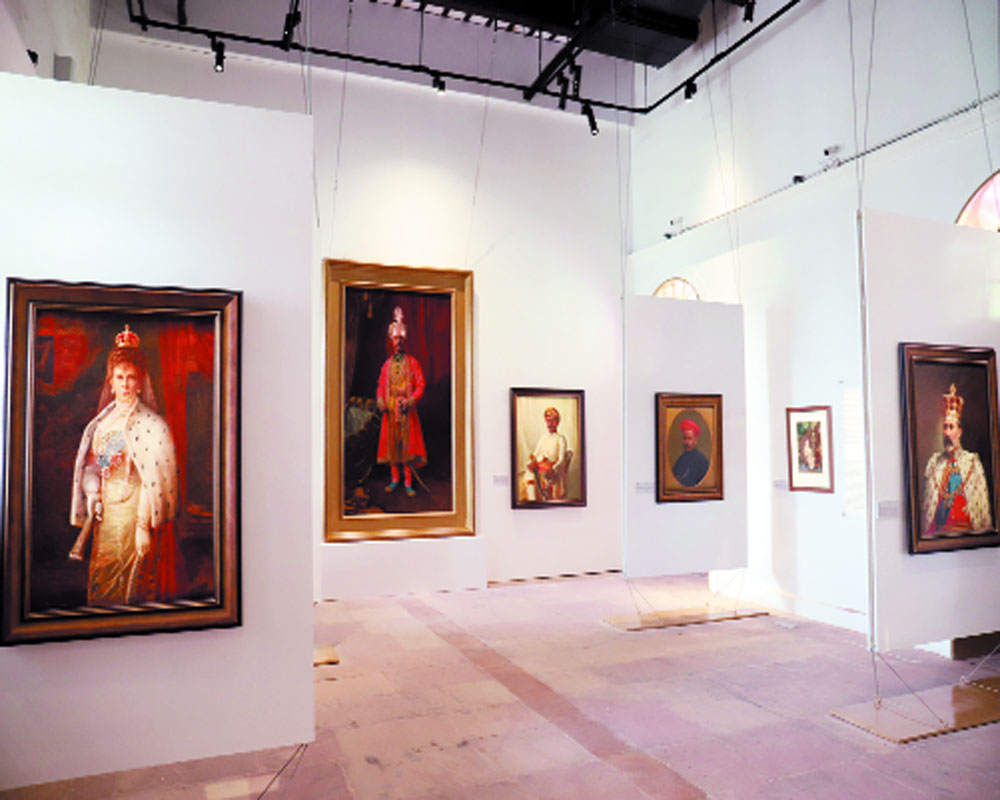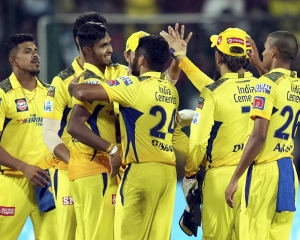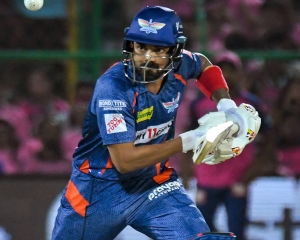Saimi Sattar takes a walk through Drishyakala, an exhibition at the Red Fort, which documents the period from the 16th century to Independence
One gets a feeling of travelling back in time. The image is familiar, yet it is not, for it has been stripped of any appearance of modernity, including the chaos that becomes normal when there is an abundance of human population. An elephant cart pulling a load next to the footsteps of Delhi’s Jama Masjid has the possibility of holding the viewer enthralled. Then there are the chariots of Mahabalipuram, no longer placed within the sanitised surroundings of today but rather appearing to be straight out of Mowgli’s world akin to the old, abandoned palace inhabited by King Louie.
The 144 prints by Thomas and William Daniel, which featured in the six volumes of Oriental Scenery published between 1795 and 1808, occupy the top floor of the Drishyakala exhibition, which is being displayed at Barrack number 4 inside the Red Fort, a monument which can be considered to be the heart of Shahjehanabad. Put together by the DAG, these works are a part of one of the four exhibitions done with the Archaeological Survey of India as part of the public-private partnership. They represent the story of India between the 16th century to the Independence.
These exhibitions, which have works from private collections, museums and more, took more than six months to put together. “We got in touch with curators from outside DAG in 2017 and started towards the end of the same year. But it was in the last six or seven months that work started on it in full swing,” says Poonam Baid, Researcher and Project Coordinator, Exhibitions & Publications, DAG.
There was a definite idea behind putting this up at a central place which does not fall into the realm of a traditional art gallery. “The idea behind putting these up at the Red Fort, which features on the list of must-visit for everyone and not just art afficionados, is to cater to the common people who would not otherwise visit something like the Art Fair. Besides, it would give them a sense of belonging to their heritage. This would enable them to see the national art treasures together, which have never been seen before,” says Poonam. The effort seems to be bearing fruit as about 2,000-3,000 people are coming in every day. The way they browse and even the discussions that they have among themselves make it apparent that this is their first brush with art at close quarters. “We want to hold their attention. Our primary motivation was to reach out to them with important art works,” she says.
So, while the ground floor has the works of nine National Art Treasures, Abanindranath Tagore, Amrita Sher-Gil, Gaganendranath Tagore, Jamini Roy, Nandalal Bose, Nicholas Roerich, Rabindranath Tagore, Raja Ravi Varma, and Sailoz Mookherjea, the first floor is dedicated to portraits, which include those which are academic as well as royal, by impressionists and expressionists, and also popular prints during the period of freedom struggle and Independence. “Many of these canvasses and water colours were done to build a momentum towards popularising art in that period and that is how prints came in the picture,” says Poonam. It is on the third level that the works of Daniels feature.
However, there are also overlaps. So while Raja Ravi Verma made paintings, he also set up the lithographic press and became the first person to print a picture in India. “He was a pioneer who set up a press and churned out oleographs and lithographs of his paintings so that every home had a Raja Ravi Verma as these were representation of divinities,” she points out. However it is not just the prints which make the cut at the exhibition. Verma was a master draughtsman and so his sketchbooks too have been put on display.
At the entrance itself, flanked on either side by rooms that display the works of the nine artists, is the Indian Constitution adopted on January 26, 1950 which was not a printed document. It was entirely handcrafted by the artists of Shantiniketan under the guidance of one of the national treasures, Acharya Nandalal Bose, with the calligraphy texts done by Prem Behari Narain Raizada in Delhi.
Another important work by the artist is the Haripura that Nandlal did for the 1938 Congress session. “We felt that this was important due to its historical context and people should see it. But there is also a mythological print as well as nature studies that he did in Shantiniketan and some collages. So all the genres of the artist and what all of them represent can be seen,” says Poonam.
An early work of Jamini Roy for instance does not show the influence of the Kalighat Pat (Kalighat painting), which was a style of art with bold sweeping brush-strokes, that the artist is known for. On the contrary, it can be classified more in the genre of an impressionist landscape which is representative of his early works.
Similarly Amrita Sher-Gil’s works are showcased not just by her paintings but also by a sculpture of two wild cats — one of the few done by the artist.
“The works of these nine artists cannot be exported,” informs Poonam. She also says that this is one of the biggest exhibitions which has works of all of the nine artists under one roof. “We selected the paintings on the basis of every genre, different kinds of work and when it was done by the artist. It also includes unseen works,” she adds.
As an aside to this particular show, there are also timelines of each of the artists which highlight the important dates in their lives. Additionally, there are also films on each of the exhibitions to enable the public to better understand the idea, the artist as well as the works on display.
Moving on to the next floor, there are portraits of all sizes and classifications. “People are interested in the rajas and the royalty. A lot of thought process has gone into what would people like to see. You can engage with an academic portrait and look at the ornamental jewellery while being exposed to a legacy which has been put together,” she says.
Many of these paintings look like they have been done in a studio setting. Poonam explains the reason for this. “These paintings often took off from photographs. The artists would imagine a studio with drapes and cushions and include these in the paintings.”
There is also an interesting story behind how Indian artists started doing portraits. Poonam says, “When travelling European artist like Frank Brooks were given commissions to paint portraits, the Indian artists realised that the foreigner is getting good money for painting the maharaja. Moreover, making a life-size portraits was royal and regal which added more value to their art which the Indian artist was quick to understand. As a result, they too started doing commissioned works during the 18th and 19th century.” Interestingly, while the subjects are documented, often there is no trace of the artists who remain anonymous since they were doing commissioned portraits and did not sign it.
A really massive painting made by Bourn and Shepard shows Nawab Mohammad Ali Khan Bahadur (1881-1947) of Malerkotla, Punjab done in the 1930s. An oil on canvas, it shows him in his regalia. The colours are fresh and well-preserved, including greens which have tendency to fade away. “It still has its original frame which weighs 380 kg and it required 12 people to carry it. The massive 108.0 x 60.0 inch painting was brought in separately and framed here,” says Poonam.
However, it was not just the royalty which was getting their likeness painted. There is an entire section on Parsis, who were the first people who got into trades and businesses. “The royalty and the rajas were getting their portraits done and since the Parsis considered themselves next to royalty, they too commissioned artworks. They used to sit in the studio settings and got these made by artists like Pithawala or Pestonji Bomanji as they had the money to get it done.”
Another section is devoted to artists who have made self-portraits like the ones by Pestonji Bomanji or Kishori Roy. There is also a photograph which has been hand-tinted to make it look like a painting.
On this floor, there are more prints, all of which are again anonymous. Most of the time, it is only the name of the press that one comes to know of, while the artists would by and large remain anonymous. The prints are divided into sections, so there is a representation of the heads of each of the princely states, a recreation of the 1911 Coronation or even one of George V and the royal consort Queen Mary in the one which pertains to the time of the British Raj. There is a separate section on the freedom struggle, which is rich in its representation of the heroes of the time, primarily Mahatma Gandhi and Subhash Chandra Bose. What is interesting to note is that while the ones from the British Raj are more formal and stiff, these are more of a representation that is rooted in popular culture. “A lot of literature was being written, which included caricature and sarcasm, during the freedom struggle. It was important to give representation through means of visual media as people can associate this easily with what they were reading,” says Poonam.
The post-Independence section includes not just calendars but advertisements as well. The changing mood in the country can best be summed up by the addition of ‘Shri’ which is considered auspicious to the name of what was essentially a British company.
“We have tried to put together the prints according to how it was happening. These prints started with Brutish era and go on to the Freedom Struggle and Independence. So while being divided into sections, it is also chronological but then some of the events were happening simultaneously. So overlaps are obviously there are many things were happening simultaneously,” says Poonam.
Two smaller rooms also have newspapers, many of which have since then shut, on display. However, it is the third section on the second floor which is really captivating. The Daniels — William and Thomas — who were uncle and nephew were also artists who travelled across India starting from Calcutta in 1788. They did a series of prints. “The Daniels did something which was interesting. They started at one point and finished at another and whatever they saw, they documented. So it is essentially a documentation of India at that time,” she says. Not surprisingly, these have become an important historical document. As has the exhibition.
(The Drishyakala exhibition is on display till July 31 at the Red Fort.)


























